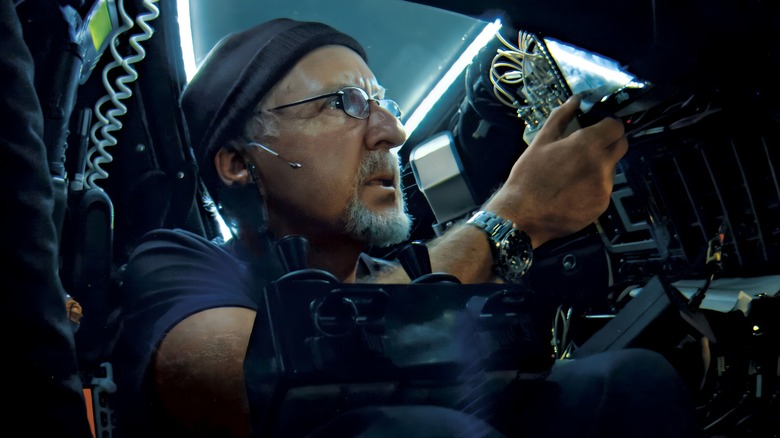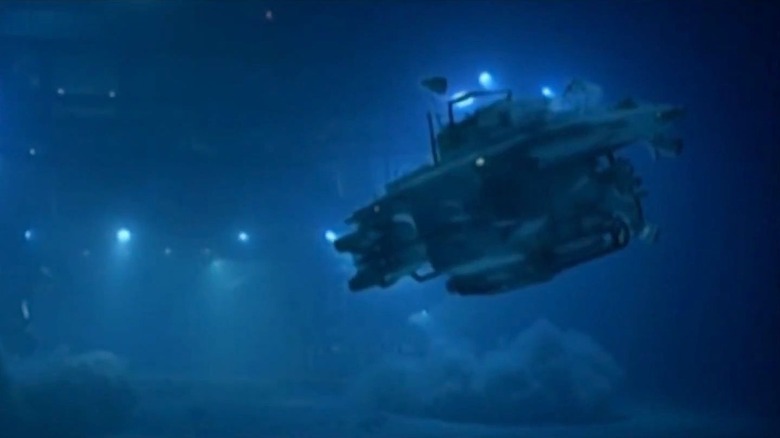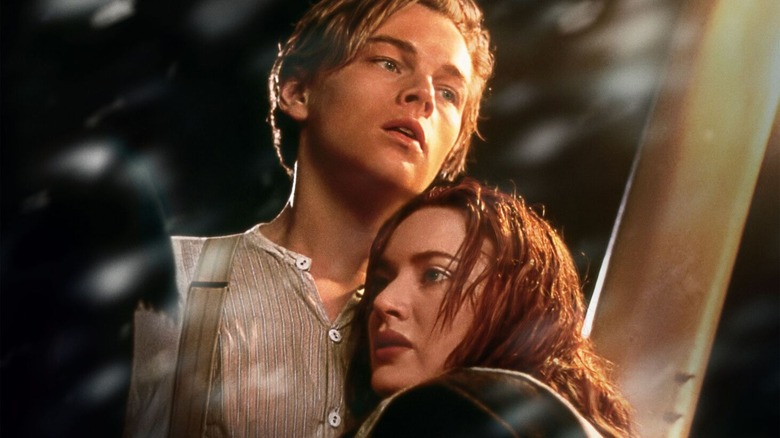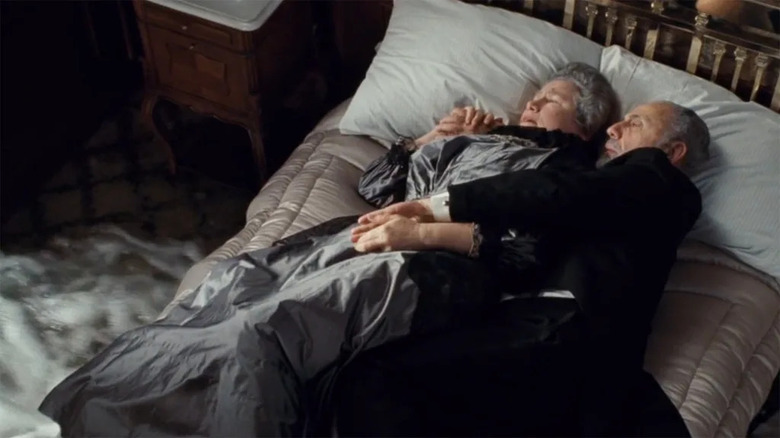Titanic Director And Titanic Enthusiast James Cameron Has Some Informed Thoughts On The Recent Sub Tragedy
When examined closely, the majority of director James Cameron's filmography is one big cautionary tale for humanity. Whether it's allowing technology to run amok, abusing nature and its resources, or generally being so arrogant as to almost wage war on a peaceful species who would wipe us out if we did, Cameron has been particularly observant about humanity's penchant for inviting disaster. Nowhere is that more apparent than in his magnum opus, 1997's "Titanic," a movie about the 1912 shipwreck disaster which Cameron spent years meticulously researching, let alone making.
Despite the existence of such a forthright and historically accurate film, it seems people are doomed to continue repeating history, as the recent OceanGate tragedy demonstrates. This past weekend, four passengers and a pilot intended to take the Titan submersible to a depth of about 3,800 meters to view the RMS Titanic's wreckage. However, they went missing, and after a series of mishaps, miscommunication, and revelations of poor preparation and planning, it was announced that the passengers had died after the craft experienced a "catastrophic loss of the pressure chamber," according to the U.S. Coast Guard.
Cameron recently spoke to ABC News about the tragedy, wearily pointing out the unfortunate similarities between an event that took place 111 years ago and one that just happened this week.
Deep submergence diving is a 'mature art' with no prior fatalities
In his interview with ABC News, James Cameron reiterated that he's very familiar with the Titanic wreckage site itself, having been down there numerous times in a vehicle he helped design. He also made sure to point out that the "art" of deep-sea diving is not a new or even historically dangerous one. Here's what he had to say:
"Deep submergence diving is a mature art. From the early '60s — where there were a few accidents, nobody was killed in the deep submergence — until now, is more time than between Kitty Hawk and the flight of the first 747. So if we haven't improved over that period of time ... we have improved drastically over that period of time. And the certification protocols that all other deep submergence vehicles except this one that carries passengers, especially paying passengers — all over the world, in tropical waters, deep coral reefs, other wreck sites, and so on — the safety record is the gold standard. Absolutely. Not only no fatalities but no major incidents."
Despite there being such a great track record, Cameron admitted that the possibility of implosion is always "first and foremost" in the minds of the divers and engineers like himself. He explained that safety is so paramount to him that he worked on testing one particular submersible for three years "just in the computer" before ever actually making it, let alone climbing inside it.
'I'm struck by the similarity of the Titanic disaster itself'
The Academy Award-winning director went on to say that he and others in the submersible community had a lot of doubt about the OceanGate approach. Sadly, attempts to get the company to rethink its actions failed, with even a letter from the Manned Underwater Vehicles committee of the Marine Technology Society to Oceangate CEO Stockton Rush going ignored back in 2018.
That, plus such factors as the way a potential lawsuit regarding the depths the company could safely travel to was dismissed, and Rush bragging about using a now infamous gaming controller to pilot the craft itself adds up to a tragedy that is eerily close to how events transpired on the Titanic back in 1912. (For what it's worth, the Military commonly uses video game controllers.) Cameron elaborated:
"The top players in the deep submergence engineering community even wrote letters to the company, saying that what they were doing was too experimental to carry passengers, and it needed to be certified, and so on. So, I'm struck by the similarity of the Titanic disaster itself, where the captain was repeatedly warned about ice ahead of his ship and yet he steamed at full speed into an ice field on a moonless night, and many people died as a result. And for a very similar tragedy where warnings went unheeded to take place at the same exact site, with all the diving that's going on all around the world — I think is just astonishing. It's really quite surreal."
Even more 'surreal' parallels between OceanGate and Titanic
While it may be tempting to dismiss the similarities between the Titanic and OceanGate tragedies as coincidences, the two incidents have a disturbing number of elements in common. Not just by comparison, either; in fact, Stockton Rush's wife, Wendy Rush, is the great-great-granddaughter of Isidor and Ida Straus, a couple who died in the actual Titanic wreck when they elected to stay onboard in order to let others escape instead. They also acted as inspiration for one of the most memorable moments in Cameron's film, when an elderly couple embraced one another in bed, accepting their fates.
Just about any way you look at it, the OceanGate tragedy seems both bitterly ironic and utterly avoidable, and it's the surreality of that which many of us are dealing with, especially Cameron himself. He suffered a personal loss in this incident as well, as longtime friend and Titanic explorer Paul-Henri "PH" Nargeolet was aboard the Titan when it imploded. Cameron observed this upsettingly bizarre part of the tale, too:
"PH Nargeolet, the French legendary submersible dive pilot was a friend of mine. You know, it's a very small community. I've known PH for 25 years, and for him to have died tragically in this way is almost impossible for me to process."
Though the lessons to be learned from this in the deep submergence diving world seems obvious, there's a takeaway for the world here, too: heed the warnings of history, art, and storytellers. If too many of us think "It's just a movie" and "It can't happen to us," then that only makes it more possible that it will.



